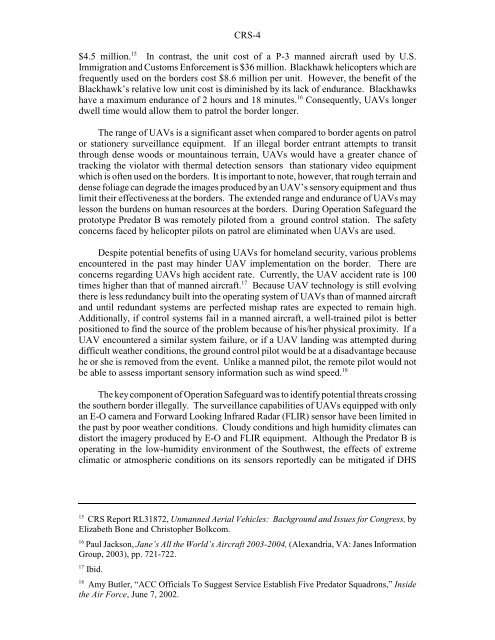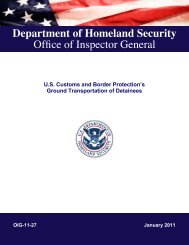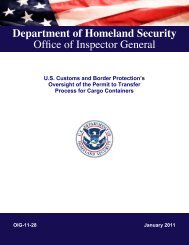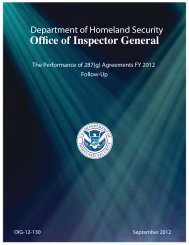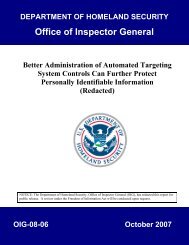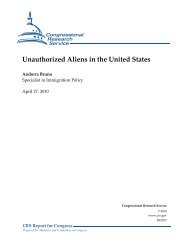Border Security and Unmanned Aerial Vehicles
Border Security and Unmanned Aerial Vehicles
Border Security and Unmanned Aerial Vehicles
You also want an ePaper? Increase the reach of your titles
YUMPU automatically turns print PDFs into web optimized ePapers that Google loves.
CRS-4$4.5 million. 15 In contrast, the unit cost of a P-3 manned aircraft used by U.S.Immigration <strong>and</strong> Customs Enforcement is $36 million. Blackhawk helicopters which arefrequently used on the borders cost $8.6 million per unit. However, the benefit of theBlackhawk’s relative low unit cost is diminished by its lack of endurance. Blackhawkshave a maximum endurance of 2 hours <strong>and</strong> 18 minutes. 16 Consequently, UAVs longerdwell time would allow them to patrol the border longer.The range of UAVs is a significant asset when compared to border agents on patrolor stationery surveillance equipment. If an illegal border entrant attempts to transitthrough dense woods or mountainous terrain, UAVs would have a greater chance oftracking the violator with thermal detection sensors than stationary video equipmentwhich is often used on the borders. It is important to note, however, that rough terrain <strong>and</strong>dense foliage can degrade the images produced by an UAV’s sensory equipment <strong>and</strong> thuslimit their effectiveness at the borders. The extended range <strong>and</strong> endurance of UAVs maylesson the burdens on human resources at the borders. During Operation Safeguard theprototype Predator B was remotely piloted from a ground control station. The safetyconcerns faced by helicopter pilots on patrol are eliminated when UAVs are used.Despite potential benefits of using UAVs for homel<strong>and</strong> security, various problemsencountered in the past may hinder UAV implementation on the border. There areconcerns regarding UAVs high accident rate. Currently, the UAV accident rate is 100times higher than that of manned aircraft. 17 Because UAV technology is still evolvingthere is less redundancy built into the operating system of UAVs than of manned aircraft<strong>and</strong> until redundant systems are perfected mishap rates are expected to remain high.Additionally, if control systems fail in a manned aircraft, a well-trained pilot is betterpositioned to find the source of the problem because of his/her physical proximity. If aUAV encountered a similar system failure, or if a UAV l<strong>and</strong>ing was attempted duringdifficult weather conditions, the ground control pilot would be at a disadvantage becausehe or she is removed from the event. Unlike a manned pilot, the remote pilot would notbe able to assess important sensory information such as wind speed. 18The key component of Operation Safeguard was to identify potential threats crossingthe southern border illegally. The surveillance capabilities of UAVs equipped with onlyan E-O camera <strong>and</strong> Forward Looking Infrared Radar (FLIR) sensor have been limited inthe past by poor weather conditions. Cloudy conditions <strong>and</strong> high humidity climates c<strong>and</strong>istort the imagery produced by E-O <strong>and</strong> FLIR equipment. Although the Predator B isoperating in the low-humidity environment of the Southwest, the effects of extremeclimatic or atmospheric conditions on its sensors reportedly can be mitigated if DHS15CRS Report RL31872, <strong>Unmanned</strong> <strong>Aerial</strong> <strong>Vehicles</strong>: Background <strong>and</strong> Issues for Congress, byElizabeth Bone <strong>and</strong> Christopher Bolkcom.16Paul Jackson, Jane’s All the World’s Aircraft 2003-2004, (Alex<strong>and</strong>ria, VA: Janes InformationGroup, 2003), pp. 721-722.17Ibid.18Amy Butler, “ACC Officials To Suggest Service Establish Five Predator Squadrons,” Insidethe Air Force, June 7, 2002.


